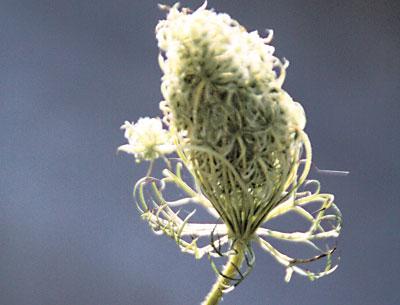Nature Notes: What Deer Won’t Eat

A month ago on a record hot Thursday, I attended a “poisonous plants” course conducted by Susan K. Pell, Ph.D., at the New York Botanical Garden. It was my first visit to that institution and one that turned out to be directly related to the vegetation in my Noyac yard.
I had wondered for more than 20 years why many of the plant species have been consistently untouched by the deer that routinely visit the yards of my neighbors.
It turns out that about two thirds of my plants are poisonous. Half of these are native to the South Fork, and half are exotic, mostly Eurasian in origin. One wonders if the deer in most cases already know which is which. In at least a few cases they learn. As spring progresses and this and that poisonous plant develop side by side with the non-poisonous ones, the deer will experiment. One day they will take the tops off many native spotted jewel-weed or touch-me-not, Impatiens capsensis, which is lush and succulent and on the face of it looks as if it would provide a good meal to any herbivore that happens by. Thereafter, they will invariably leave them be.
They never try the vinca, or periwinkle, an exotic ground-hugger that covers half the front yard. Nor will they nibble on the common import lily-of-the-valley, which covers the other half. The latter contain glycosides that can cause nausea, vomiting, diarrhea, irregular heartbeat, and more, similar to the glycosides found in the ornamental foxglove, which contains digitalis, a chemical used medicinally in the past to treat irregular heart rhythms or as a diuretic.
The deer stay away from pokeweed, a foreigner from the tropics, all of the parts of which are poisonous in mature plants, but not to catbirds, robins, and thrushes, which come by in late summer and early fall to reap the purple berries. They also leave the poison ivy alone (I wish they wouldn’t), and pay no attention to the bittersweet or daffodils. You may have noticed where daffodils spring up or are planted on shoulders of local roads, they always seem to bloom without interference from the deer, even though, as on Stephen Hand’s Path, they graze the grasses and forbs growing in between them.
I have no tomato plants, which deer seem to leave alone where they are planted widely in South Fork farm and garden plots, but I do have other members of the tobacco genus Solanum, just about all of which are toxic if ingested. The deer don’t touch the two poisonous nightshades that inveigle their way between and overtop many of my native wildflowers every year. Several insects prey on the Solanum species, while almost all mammals, except perhaps for Homo sapiens, steer clear of them.
I don’t think my several varieties of asters and goldenrods are poisonous, but they do not score high on the lists of preferred deer foods. One native plant which the deer totally avoid, to the degree that it has totally taken over my back yard, is white snakeroot, Ageratina altissima, the foliage of which contains tremetol, which makes cow milk and steer meat poisonous once ingested. On the other hand, deer like to browse the fresh spring growth at the tips of the yew branches. Yews contain taxane, which causes a bunch of maladies when ingested, but also contain taxol, a chemical that has been used to treat certain cancers in humans. Are the yew-eating deer defending themselves from developing cancers or are their metabolic systems immune to the poison?
Queen Anne’s lace, Daucus carota, a foreigner which is common throughout our area, is quite poisonous when eaten, I was surprised to discover. After all, it is the ancestor of the edible carrot. If you’ve driven along the Sunrise Highway between Westhampton and Southampton Village lately, you will see waves and waves of three-foot tall Queen Anne’s lace in full bloom. Deer abound on the shoulders of the Sunrise, but apparently they’ve come to realize that Queen Anne’s lace will give them a tummy ache.
The orange milkweed, or butterfly weed, common milkweed, and dogbane in and around my yard are also eschewed by the deer. They contain the poisons that make the monarch butterfly, whose larvae feed on them, distasteful to almost all would-be predators.
Deer don’t eat my mountain laurel, hollies, or lady ferns, all of which contain toxins. I have other native and non-native plants in my yard. But one thing has become quite clear over the 31 years I’ve resided at this address: The plants that are outright noxious and poisonous to deer passers-by are thriving. It’s all I can do to keep them at bay. In the bigger picture, one can imagine a day in the distant future when only poisonous plants and those with thorns thrive and almost all of the edible ones, except on farms and botanical gardens, will have perished. If only we could train deer to eat phragmites. Wouldn’t that be grand?
